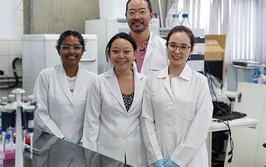Characterization of hydrodynamic changes upon cation-binding to proteins
Work performed in conjunction with the Institut Pasteur, Paris, France Cations are specifically recognized by numerous proteins. Despite their small size, their specific interactions with highly charged residues allow them to induce significant conformational changes on their binding proteins.
Characterization of hydrodynamic changes upon cation-binding to proteins
Introduction
The ability of small, highly charged cations to induce protein structural changes following binding is a fundamental process behind many biological signaling pathways. Whilst the signaling cascades controlled by cation binding are very diverse, individual cation-binding motifs are often conserved between different proteins. One such cation binding motif is the "Repeat in Toxin" (RTX) motif present on many virulence factors that is secreted by pathogenic microbes. RTX sequences are glycine- and aspartaterich domains that constitute a specific type of Ca2+ binding site that is essential for the function of such secreted toxins, including the pore-forming cytolytic toxin, adenylate cyclase toxin (CyaA). Indeed, CyaA, from Bordetella pertussis, the causative agent of whooping cough, has been shown to bind calcium in solution. The calcium dependence of these secreted toxins has been proposed to facilitate their secretion into the extracellular medium, as newly synthesized peptides would need to pass through the narrow channels of the secretion machinery. With the low calcium concentration inside the bacterial cytosol, it has been suggested that RTX motifs would form an unfolded conformation, favorable for secretion. However, once in the extracellular space, the higher calcium concentration would cause the RTX domain to bind calcium ions, and form a structured, active protein. In order to better characterize the mechanism of calcium-dependent RTX function, a series of biophysical methods were employed to study changes in both conformation and size of the RTX repeat domain (RD) of CyaA toxin, following calcium binding.

















